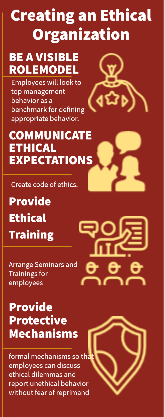Case Breakdown: Movie Rishta Kagaaz Ka
The scene that you saw shows an employee subtly trying to ask for a bribe from a customer to get his work done. He willingly pays him to get his work done. This blog, Learning Perspectives explores how companies can create an ethical culture in organizations.
How to create an Ethical Organizational Culture?
The strength of culture influences an organization’s ethical climate and the ethical behavior of its members. Organizational culture is most likely to shape high ethical standards. This could be characterized by high-risk tolerance, low to moderate aggressiveness, and focuses on means and outcomes.
Managers in such a culture are supported for taking risks and innovating. They are discouraged from engaging in bribery rather than paying attention to how goals can be achieved.
A strong organizational culture will exert more influence on employees than a weak organizational culture. If the culture is strong and supports high ethical standards, it should have a powerful and positive influence on employee behavior. For example, Tata has a strong culture that has long stressed corporate obligations to customers, employees, communities, and shareholders.
Enron’s aggressive culture with unrelenting pressure on executives to rapidly expand earnings encouraged ethical corner-cutting and eventually contributed to the company’s collapse.
What can Management do to create an Ethical Culture?
Be a Visible Role Model:
Employees will look to top management behavior as a benchmark for defining appropriate behavior. If the top management shows signs that are not in alignment with high qualities then soon the entire organization follows in the footsteps of the top management. It makes the organization shallow from within. When senior management is seen as taking the ethical road, it provides a positive message for all employees.

Communicate Ethical Expectations:
Ethical ambiguities can be minimized by creating and disseminating an organizational code of ethics. It should state the organization’s primary values and ethical rules that employees are expected to follow. For example, Johnson & Johnson’s credo is strong and clearly mentions its’ values, principles, and ethical policies.
Provide Ethical Training:
Setting-up seminars, workshops, and similar ethical training programs help the organization. They can through this training reinforce the organizations’ standards of conduct, clarify what practices are and are not permissible, and ways to address the ethical dilemma if any. People who act ethically should be visibly rewarded for their behavior. Just as, unethical acts should be punished.
Visibly reward ethical acts and punish unethical ones:
Performance appraisals of managers should include a point-by-point evaluation of how their decisions measure up against the organization’s code of ethics. Appraisals must include the means taken to achieve goals as well as the ends themselves.
Provide Protective Mechanisms:
The organization needs to provide formal mechanisms so that employees can discuss ethical dilemmas and report unethical behavior without fear of reprimand. This might include ethical counselors, an integrity helpline, ethical officers, etc.
Understand Ethical Organizations with a Video
Reference: Organizational Behavior, Robbins









[…] because the company isn’t earning any income in that particular period. Many companies adopt malpractices to escape payment towards tax. While some report profit to hide their losses to be respected in the […]
[…] It means making money through illegal ways and covering it up in such a way as to make it look ethical. Money laundering is quite often used in black […]